New Floating Discs.
Discussion
Having decided to uprate the brakes on the car, and seeing all the woes everyone seems to get associated with carbon ceramics, what with noise, imbalance and the horrific replacement costs, I decided to source some lightweight forged aluminium calipers with carbon steel drilled floating discs in 400mm, the largest I could install inside my 20” alloys and marginally larger than the DBS OEM discs..
I found some 8-pot calipers in Japan that utilise Brembo race caliper fitment pads that are used on the Audi R8, RS3/4/5/6 and TTRS. This makes sourcing a full range of pad applications and manufacturers very straightforward and replaces the standard 4-pot DB9 calipers. I will be using EBC DP41513R Yellow Stuff or DP51513 Blue Stuff pads.
Each forged, one piece front caliper houses 4 individual brake pads and is CNC machined to reduce weight and increase heat dissipation and the usual fitment of these calipers is on GT racing cars. The brake hose is attached with Titanium banjo bolts and the pads held in position with pins locked with stainless steel “R” clips. New nylon coated, stainless steel braided brake hoses are used for connection between the caliper and the vehicle.
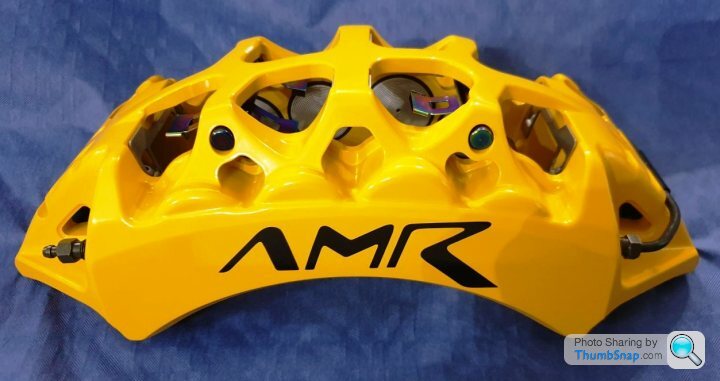
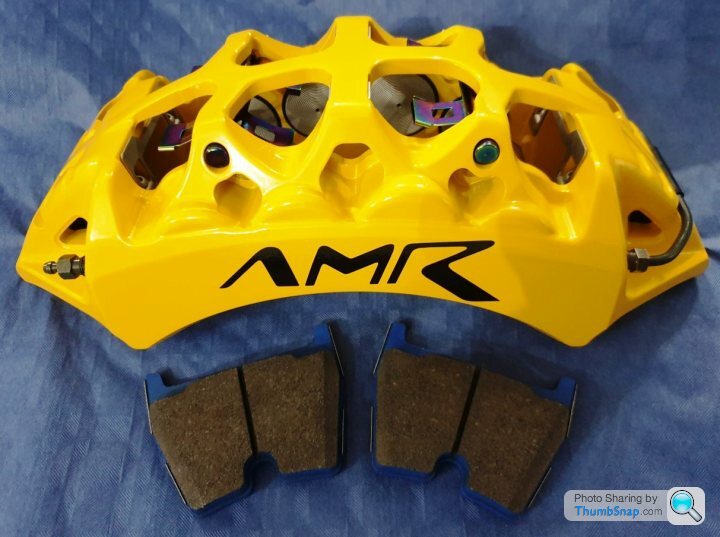
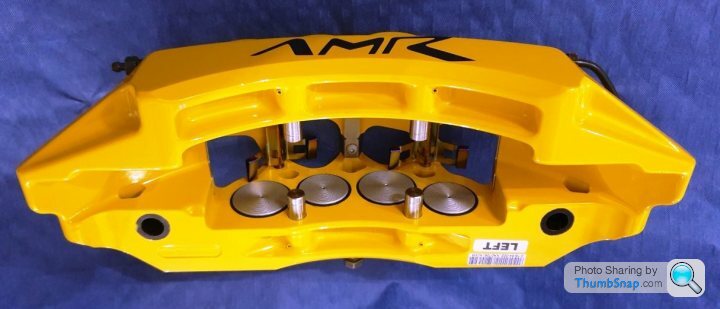
The multi-piece discs are 400mm diameter (up from 355mm) and 36mm thick (up from 32mm), with lightweight alloy anodised center bells attached through sprung loaded floating mounts with twelve, 10.9 grade hi-tensile screws and locknuts.
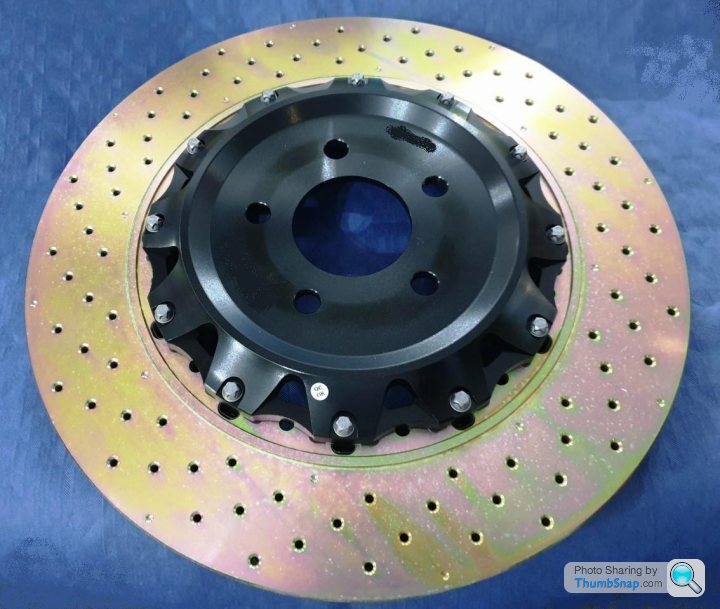
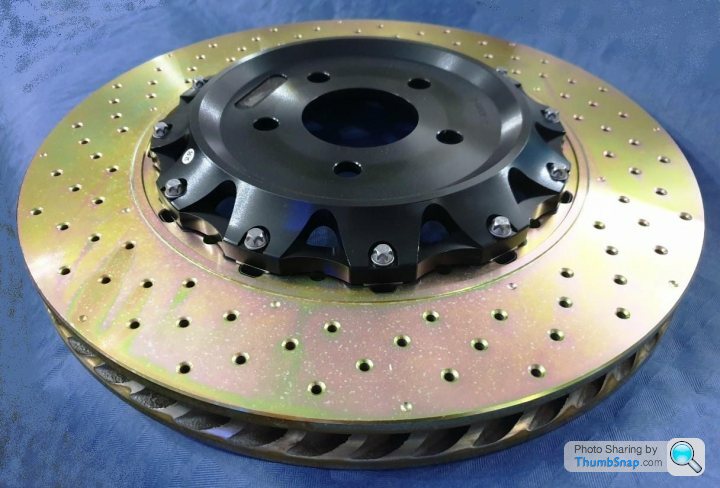
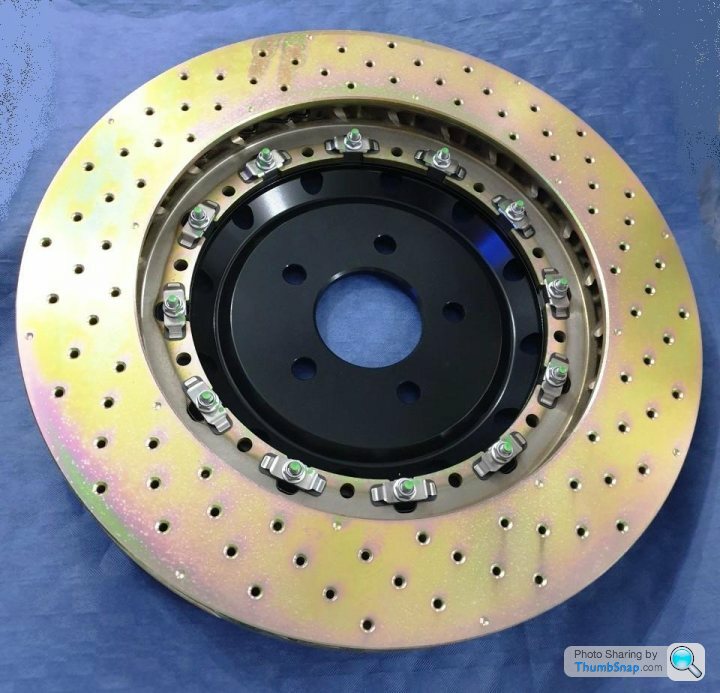
Weight comparisons with the standard 4 pot calipers are as follows:
Front 8-pot caliper 4200g
400mm 2-piece brake disc 12535g
Swept area 663 cm²
OEM front 4-pot caliper 3100g
OEM front brake discs 12020g
OEM Swept area 556 cm
Combined installed weight of 8-pots 33470g
Combined weight of OEM brakes 30240g
Unsprung weight change +11%
Braking area increase front is 20%
Brake fluid used: ATE Type 200 DOT 4.
So, the process for replacing the stock Brembo 4-Pots with the new 8-Pots was as follows.
(Please note, pics taken on a phone, one handed, whilst going through the process so not up to Haynes standards!)
I will be using the following terminology:
Parking brakes are usually called handbrakes in the UK but with new technologies of foot operated “handbrakes” and electric “handbrakes, I am using the technically correct term of parking brake.
Service brakes are the brakes operated by the footbrake pedal whilst driving, not operating a foot operated parking brake “handbrake”. Confused? Let get on with it anyway......
So here we are at the starting point, stock DB9 calipers with drilled discs and a Titanium nut and stud caliper mounting install.
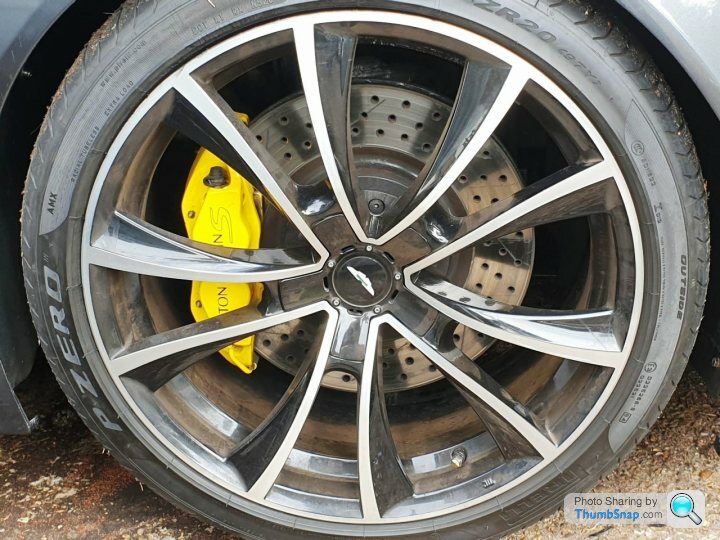
The car is lifted and supported (shown here on the offside) and the wheel removed.
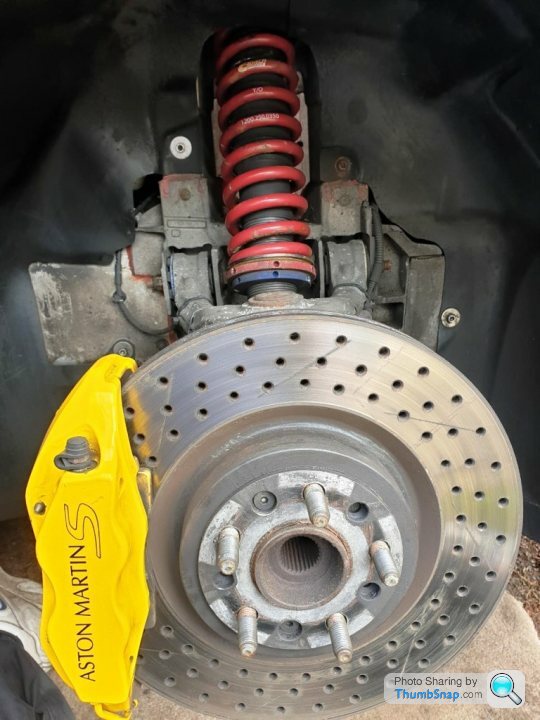
First procedure was to remove the existing pads from the caliper by gently drifting out the pad retaining pins.
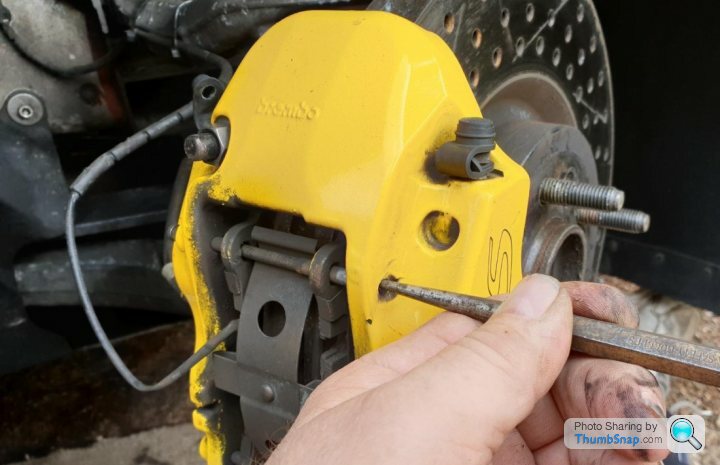
With the pins and anti-chatter clip removed, we can ease back the pads from the disc with a screwdriver.
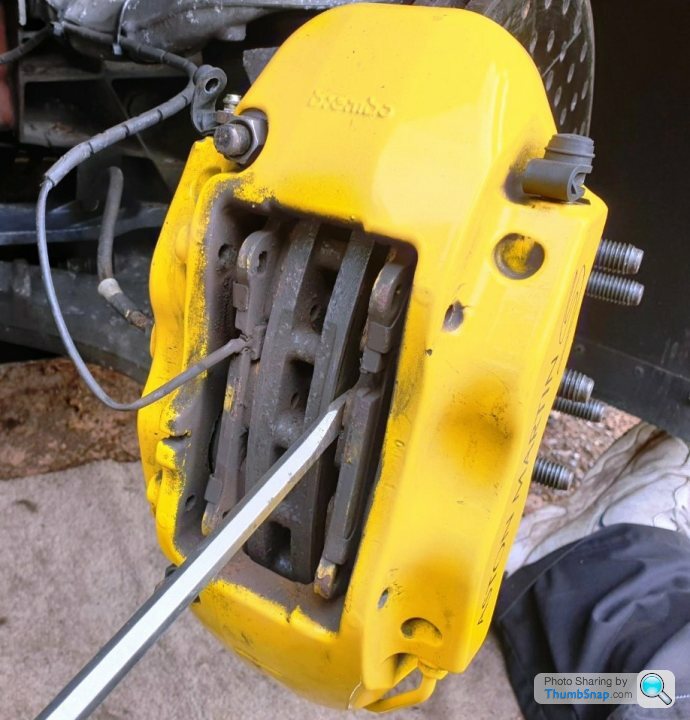
At this point we can crack off the radial caliper retaining bolts. I have previously installed the titanium nut and stud conversion to prevent hub thread damage so here I can be seen removing the 15mm titanium nuts. This kit will not be reused.
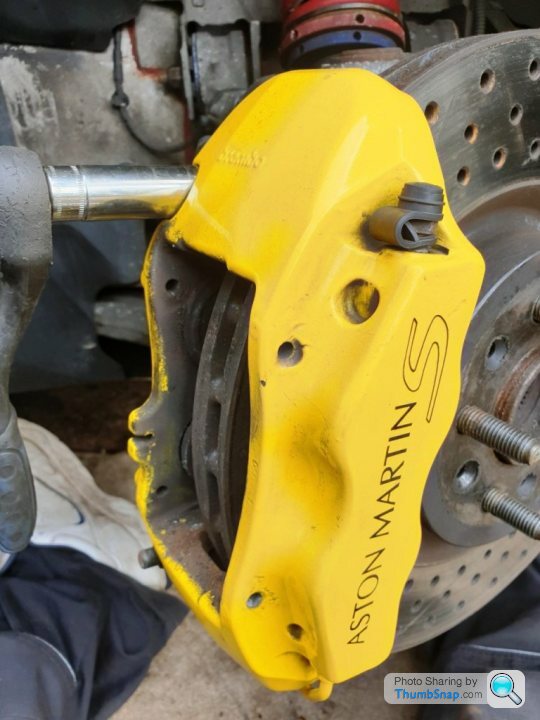
At this point, prior to removal of the calipers, it it wise to make sure you can crack off the caliper hose union whilst the caliper is still secure, also, remove the 2 5mm nexagonal socket screws that retain the disc to the hub as you can wedge the disc from rotating with a screwdriver in the disc slots.
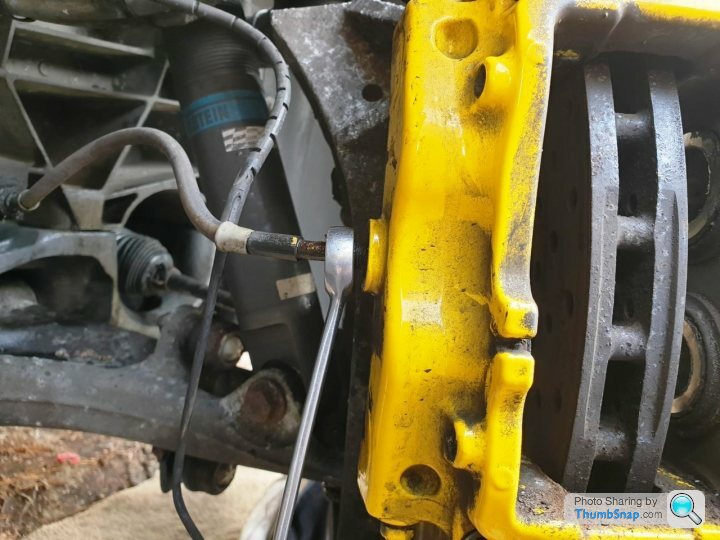
The caliper can now be removed......but do NOT let it hang on the brake hose, either support its weight with a box/block or support it as I have done on the top. You do NOT want to stress or twist/fold/bend the brake hose.
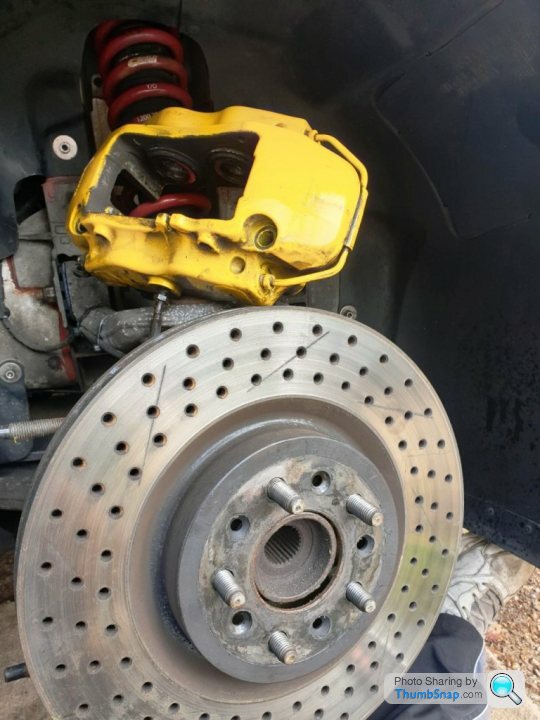
With the caliper free, and the disc retaining screws removed, the disc can be slid off the wheel studs.
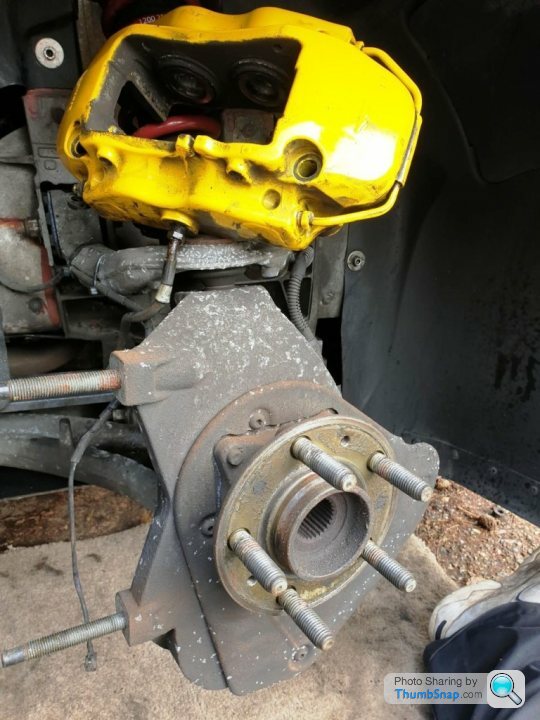
With the disc now off and the hub exposed, you can check the wheel bearing for smooth, quiet operation easily, and you can thoroughly clean the hub/disc mounting face. Wire brush, fine abrasive paper and a clean cloth to ensure a perfectly flat mating face for the new disc.
We can now install the adaptor plate for the new 8-Pot calipers to the existing hub carrier.
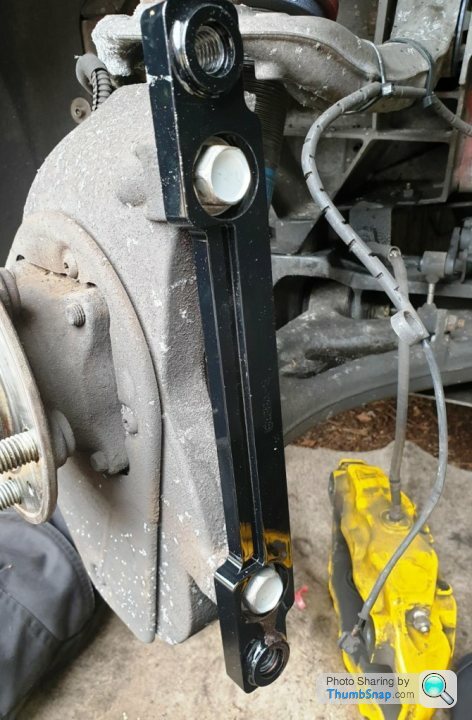
Followed by the replacement disc
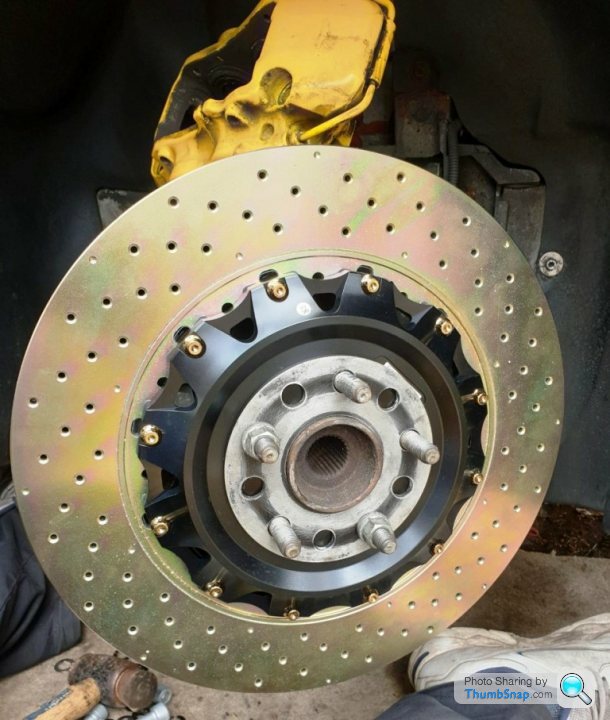
These calipers require the pads to be installed from the underside, so we now pre-load the four pads into the caliper body, preferably with the VAG type loomed pad towards the upper section of the inside position.
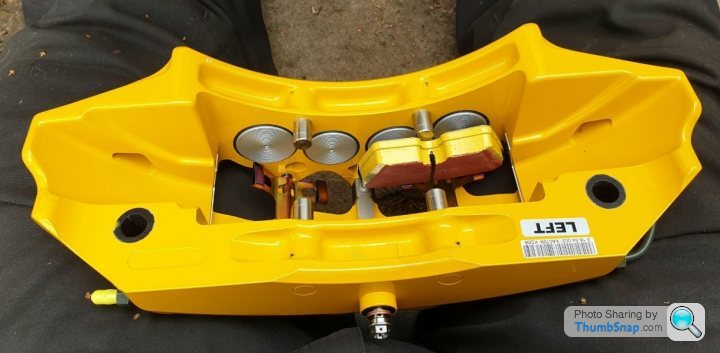
and the new 8-Pot caliper, secured by the 2 hexagon socket bolts.
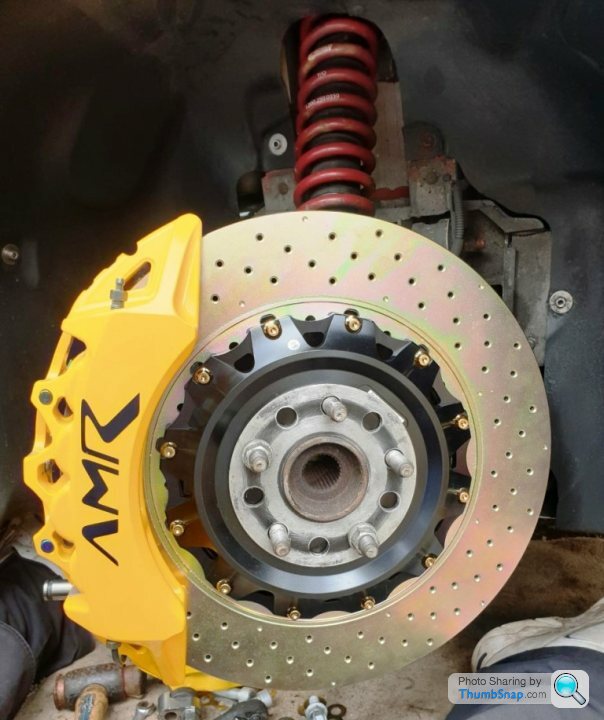
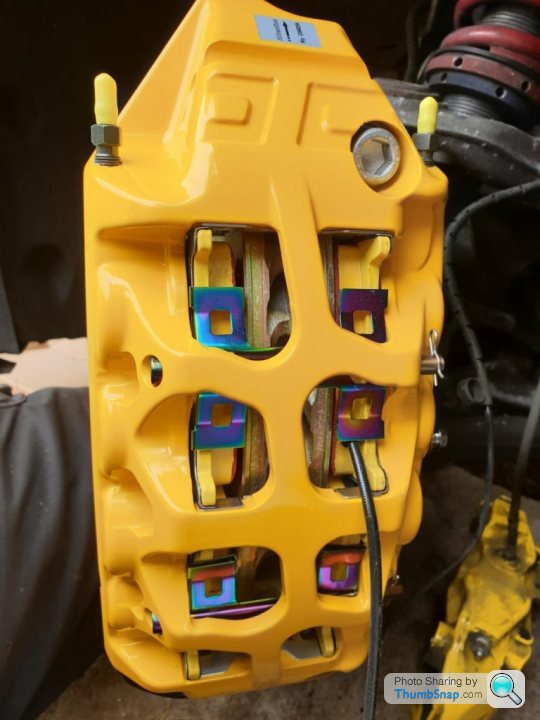
At this point, I chose to retain the pad loom warning system, so as both the AM and the VAG use a 2 wire loom system, it was a simple task to cut and strip both looms....
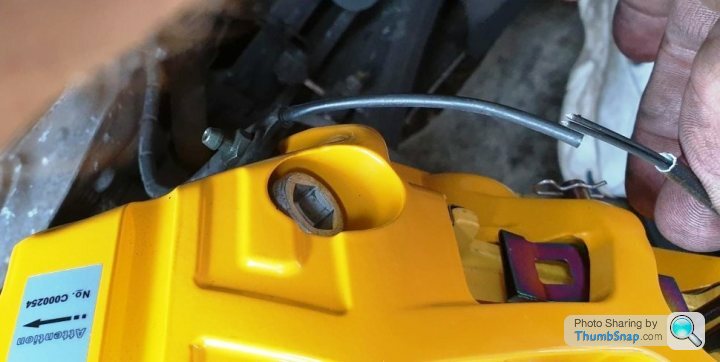
Then reconnecting them together to remake a circuit, soldered, insulated with heatshrink and then bound again in insulating tape to double seal them.
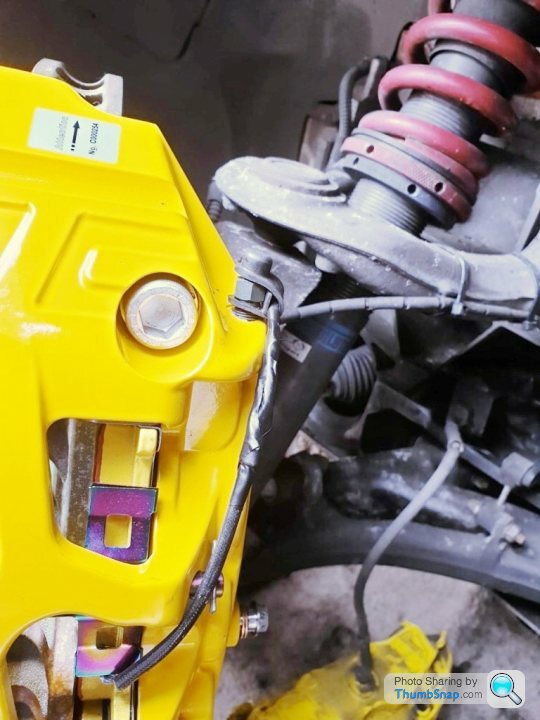
At this point it was necessary to install a replacement braided steel, nylon coated brake hose, but due to brake fluid covered hands and the general mess involved, no pics were taken of the process. Unusually, the original hoses have a bracket permanantly attached to the chassis end of the flexible hose, so I made a bracket that attached to the original hose mounting position to secure the new braided hose fitting solidly in the same position.
With the new hose fitted, the new hose and caliper were bled, inside 4 pistons first, followed by the outer 4.
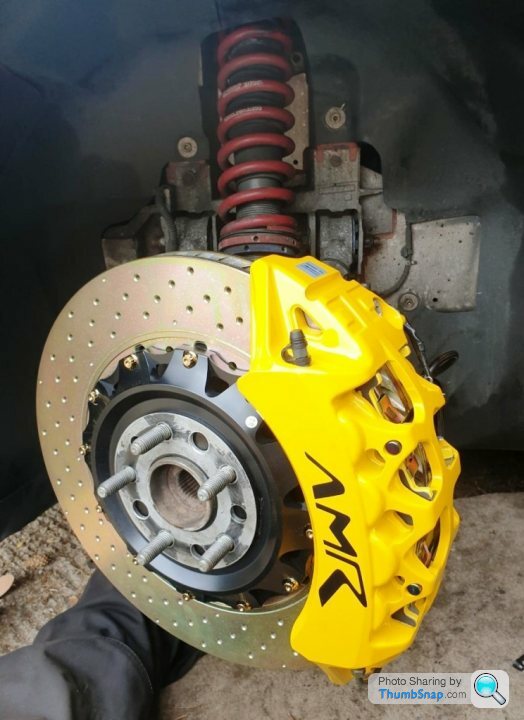
I then refitted the wheel and spun it to check for any binding or undue noises.
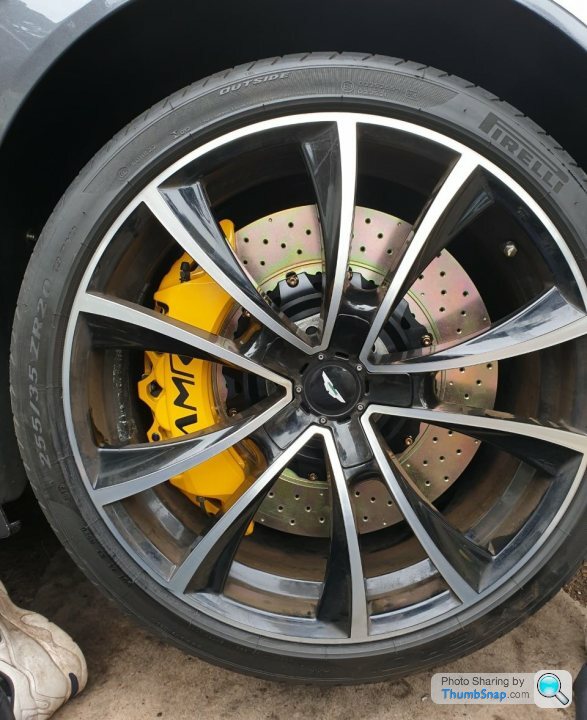
The car was then lowered back onto its wheels and the wheel nuts torqued to spec.
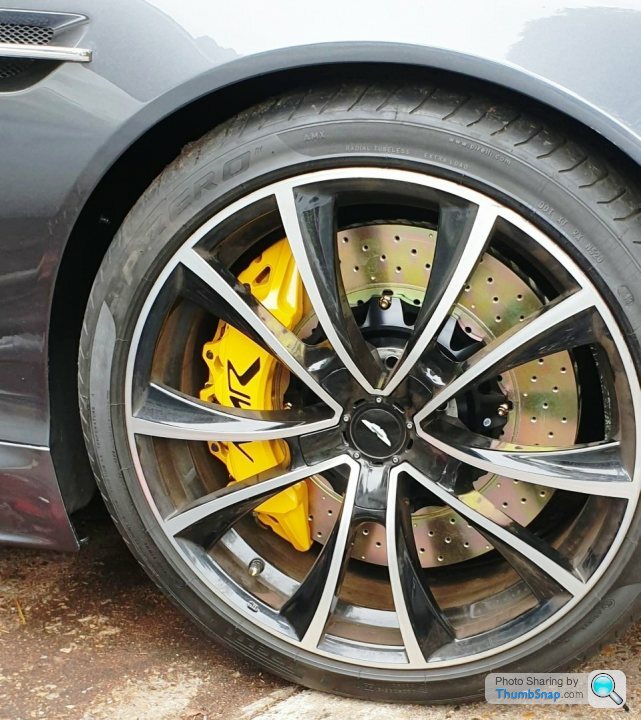
The whole procedure was then repeated on the nearside.
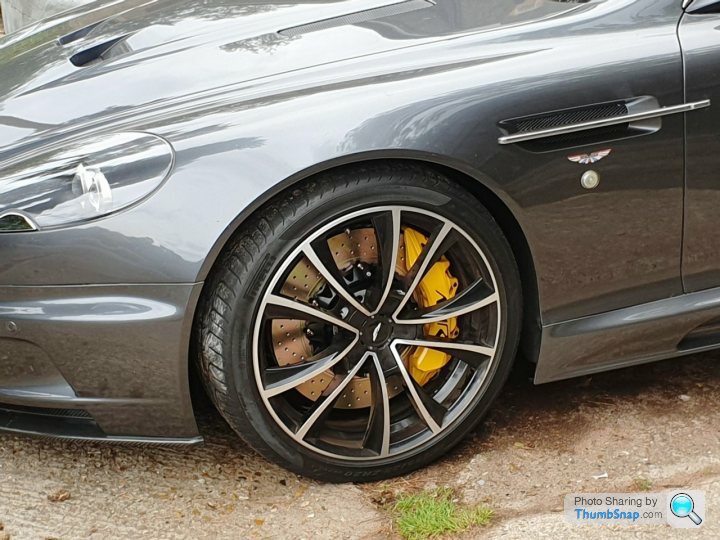
With that all successfully complete, it was time to tackle the rears, with the 4 caliper set-up and the new 380mm discs and 6-Pot calipers.
For the rear on my brake upgrade project, I decided to match my front lightweight forged aluminium calipers with carbon steel drilled floating discs, but this time with 6-pot calipers and discs in 380mm, 20mm larger than the DBS OEM and replacing the 4-pot calipers of the DB9.
I found some 6-pot calipers in Japan that utilised Alcon/AP Racing race caliper fitment pads that are used commonly in the AP CP5060/5555/5575 series of calipers, used on Holden Commodore and HSV, again making sourcing a full range of pad applications and manufacturers very straightforward. I have selected either EBC DP4032R Yellow Stuff or DP5032NDX Blue Stuff pads.
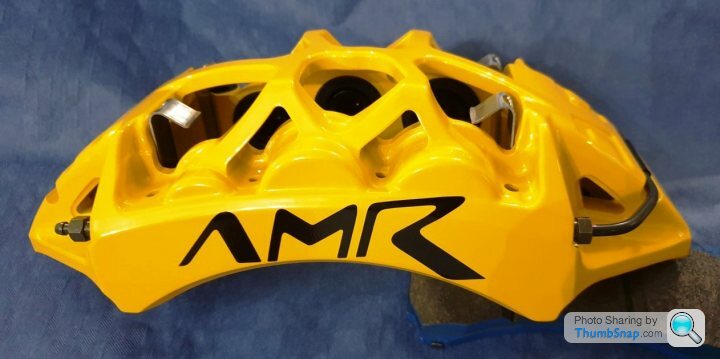
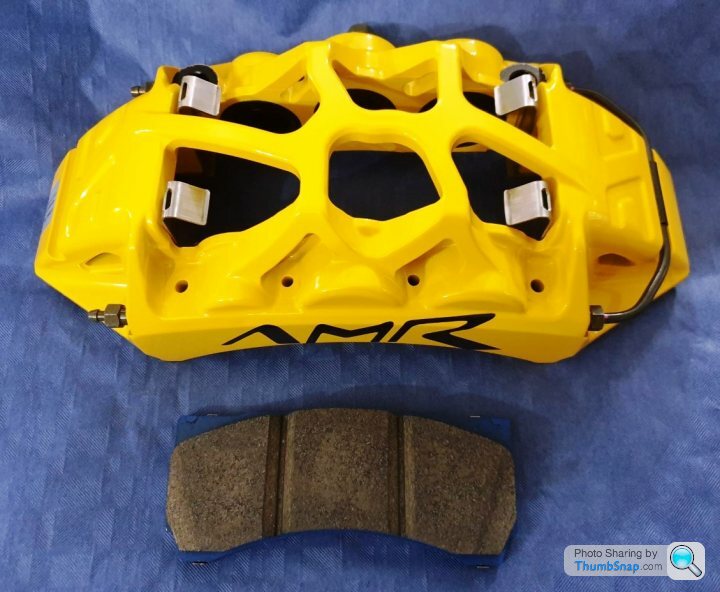
Each forged, one piece front caliper houses a pair of brake pads and like the fronts, is CNC machined to reduce weight and increase heat dissipation.
The multi-piece discs are 380mm diameter (up from 330mm) and 32mm thick (up from 28mm) and of identical construction to the fronts.
Weight comparisons with the standard 4 pot calipers are as follows:
Rear 6-pot caliper 2545g
380mm 2-piece brake disc 10725g
Swept area 583cm²
OEM rear 4-pot caliper 2655g
OEM rear brake discs 9298g
OEM drilled rear brake discs 8385g
OEM Swept area 372cm
Combined installed weight of 6-pots 26540g
Combined weight of OEM brakes 23906g
Unsprung weight change 11%
Braking area increase rear is 57%
As with the front brake installation, the vehicle is raised and supported with the wheel clear.
The first task is to remove the rear wheel assembly.
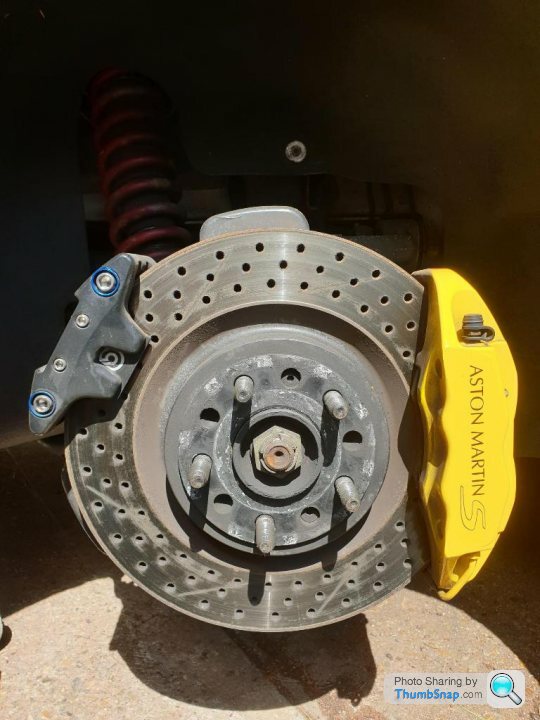
Now is a good time to remove the 2 disc securing screws retaining the disc to the hub.
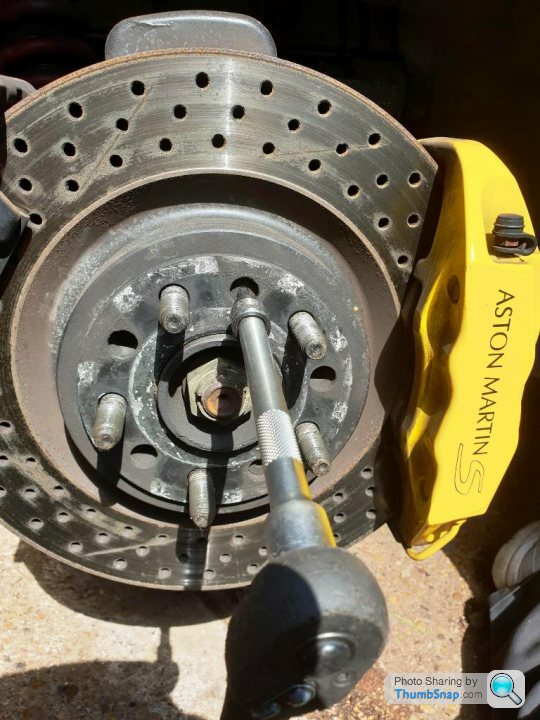
As with the front brakes, the rear service calipers are radial mounted, so first task is to loosen the mounting bolts and remove the rear service calipers in the same way as we did the fronts. Firstly the upper caliper bolt
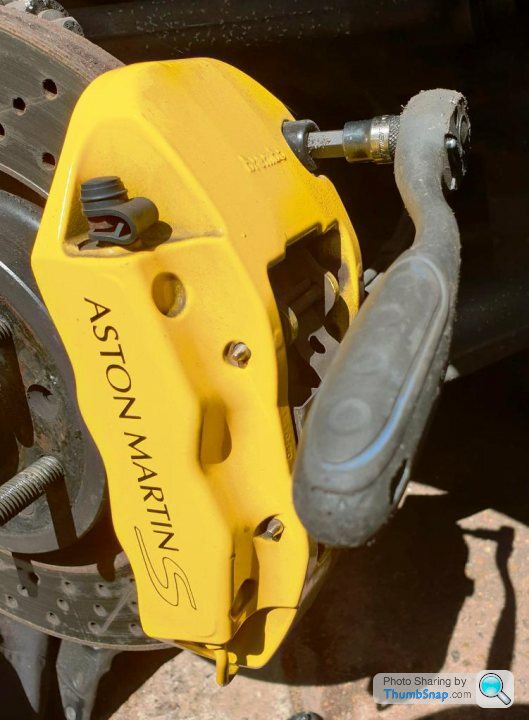
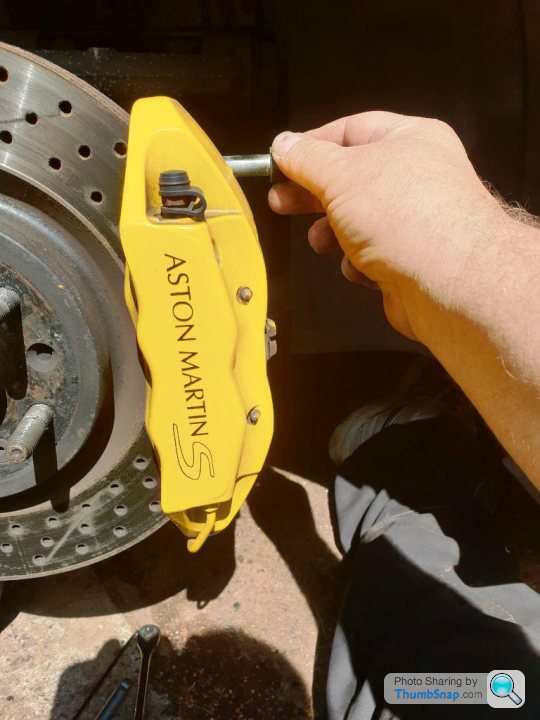
Followed by the lower
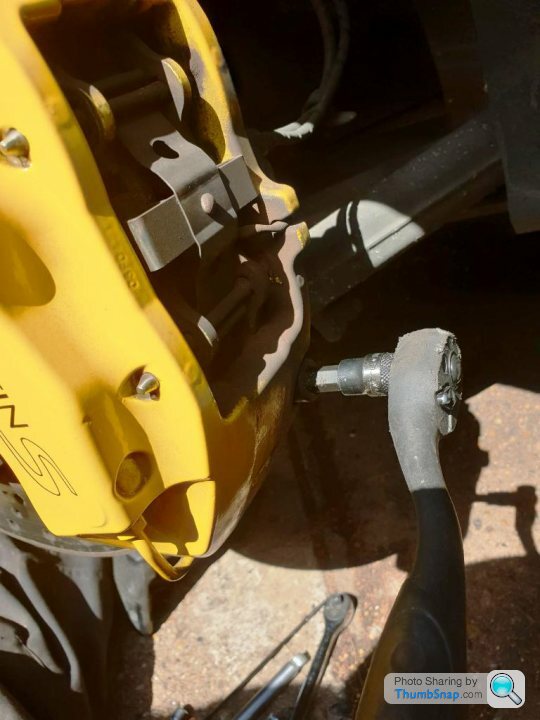
Then supporting the caliper so that it does not hang on the brake hose.
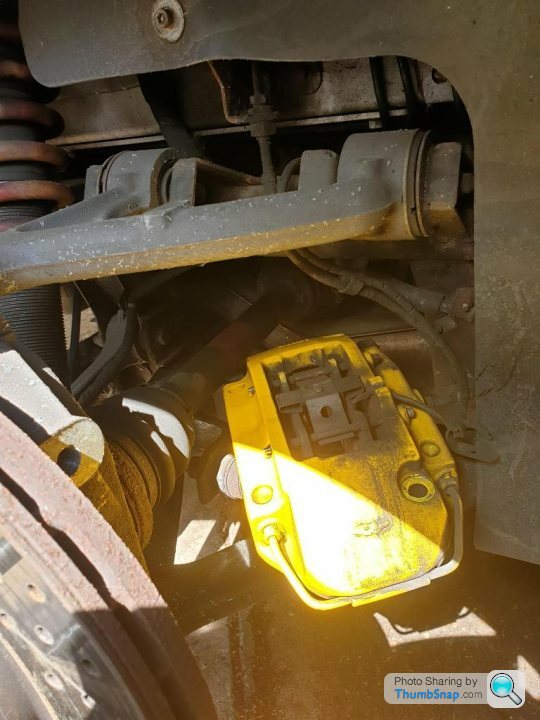
We can now loosen the rear caliper brake hose union, and remove the rear service calipers, allowing clearance to remove the rear disc once the parking caliper is also removed.
As before on the front, the disc/hub mounting face should be thoroughly cleaned.

Here we can see the old copper grease and accumulated dirt on the hub. This was washed down with aerosol brake cleaner/degreaser, then scrubbed with a wire brush to remove any hint of corrosion
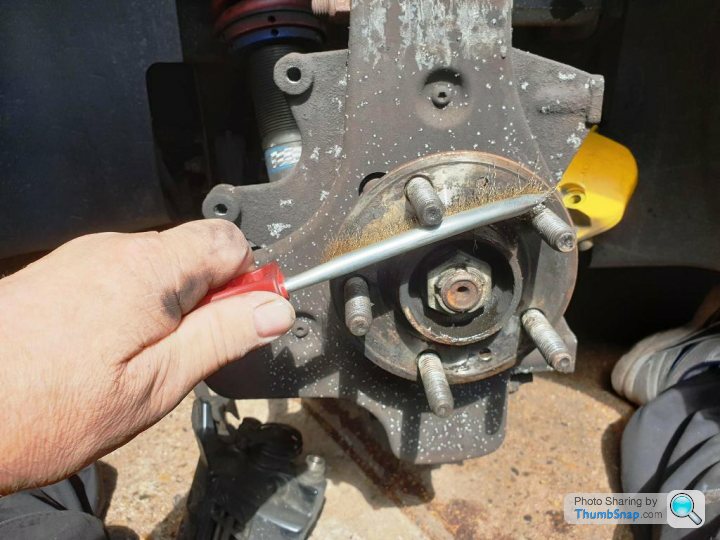
And then washed again in brake cleaner.
I then had to install the new 6 pot caliper mounting brackets to the original caliper mounting points using M12x25x1.5 bolts for the inner bracket and M12x20x1.25 bolts for the outer bracket to the inner bracket.
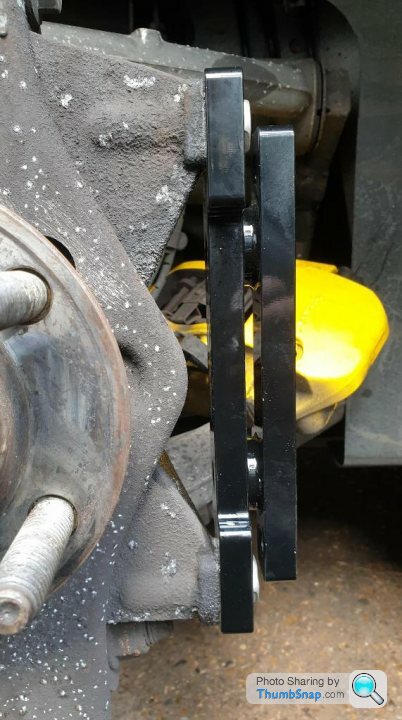
Before offering up the new 380mm disc
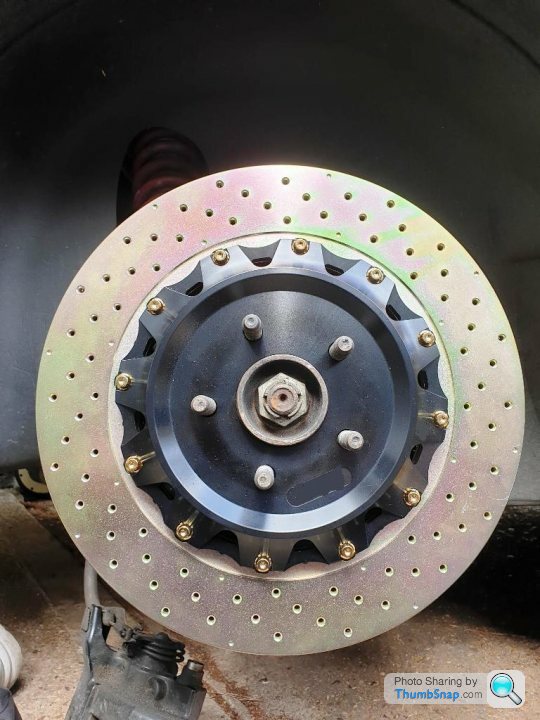
The new brake pads were then installed into the new calipers
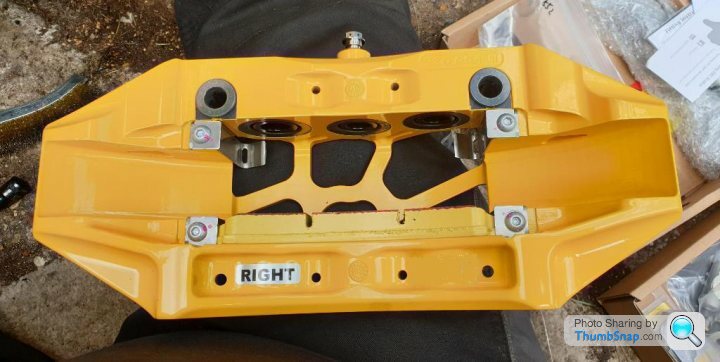
Before bolting up the new caliper using M12x57x1.25 hexagon socket bolts.
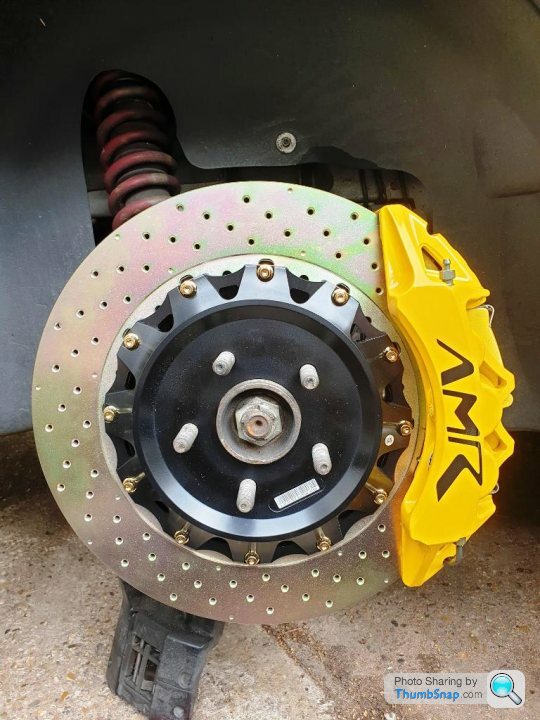
We also have the additional parking brake calipers fitted to the rear but these are more conventionally mounted. It is convenient to loosen the caliper body bolts whilst the caliper is held in position, and the pad pins can be removed and the parking brake pads withdrawn. The parking brake calipers can now be removed and moved aside by removing the 7mm hexagonal socket bolts at the rear.
The standard handbrake calipers have been retained but remounted to increase their diameter offset to accomodate the larger diameter discs,
Here we remove the upper park brake caliper mounting bolt
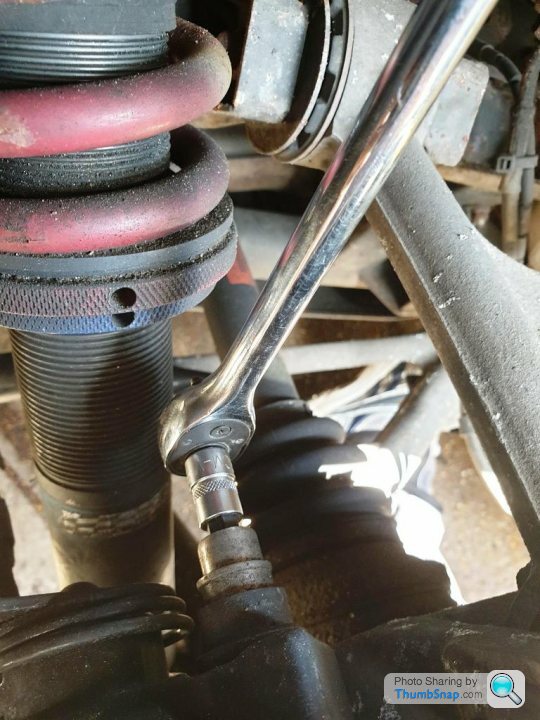
Followed by the lower
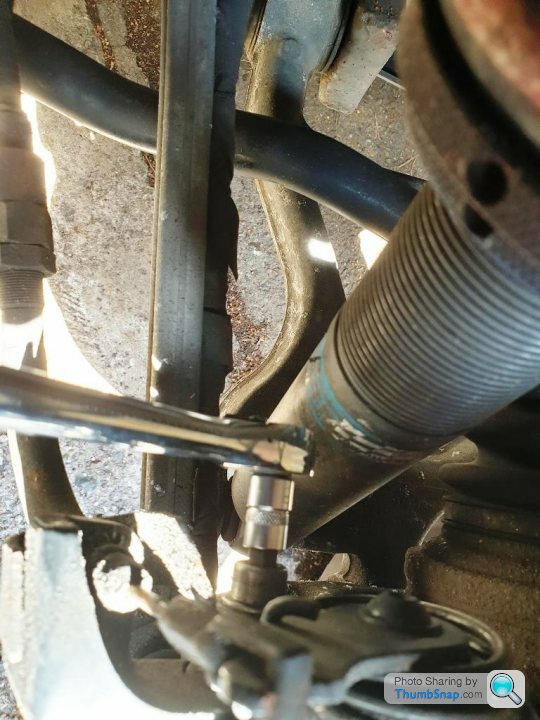
To allow for the increased rear disc diameter, the park brake caliper had to be remounted further from the centre using an adaptor mount using M10x35x1.5 bolts
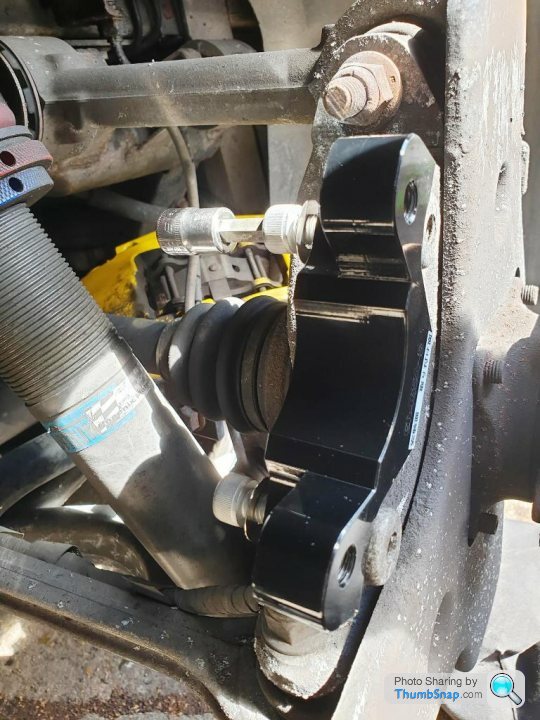
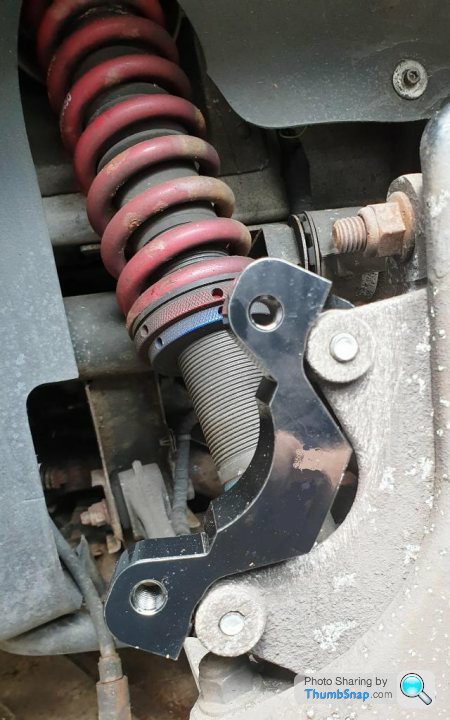
and spaced 8mm to sit over the wider discs.
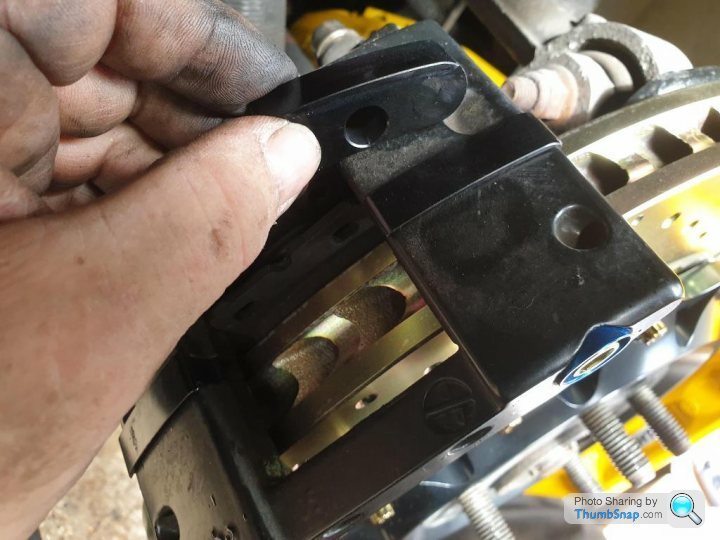
For this, I had to modify my already modified handbrake calipers......
https://www.pistonheads.com/gassing/topic.asp?t=17...
using longer M10x80x1.5 Titanium bolts to hold the caliper together and modified M6x100x1.0 Titanium bolts to act as the sliders for the pads.
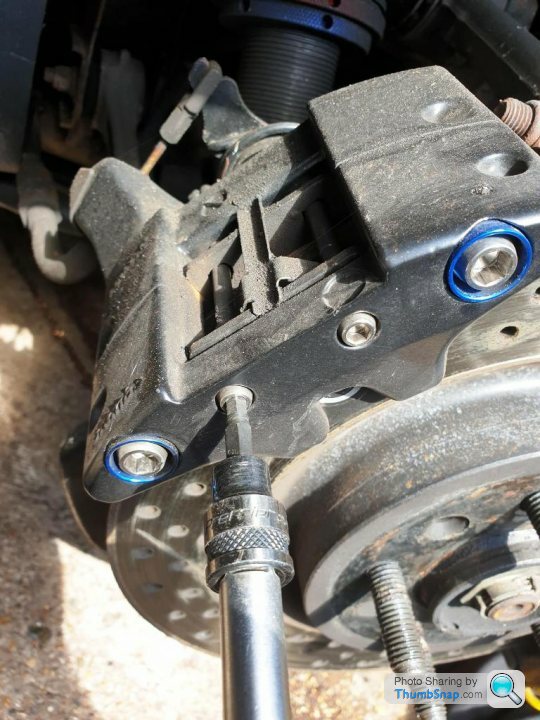
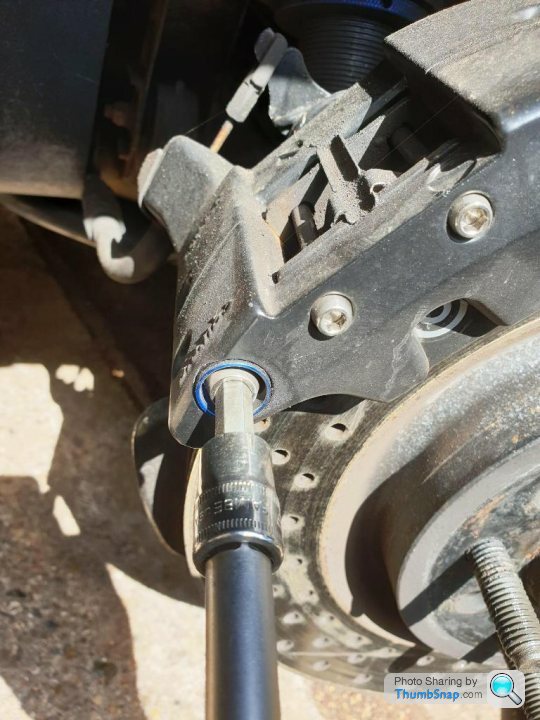
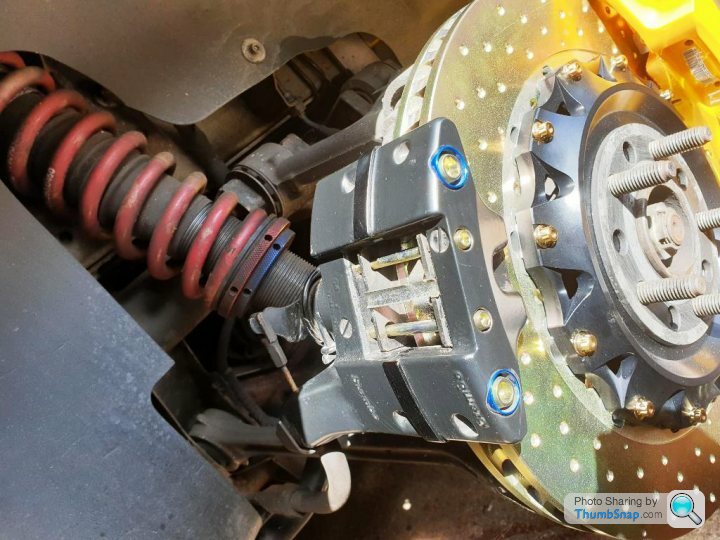
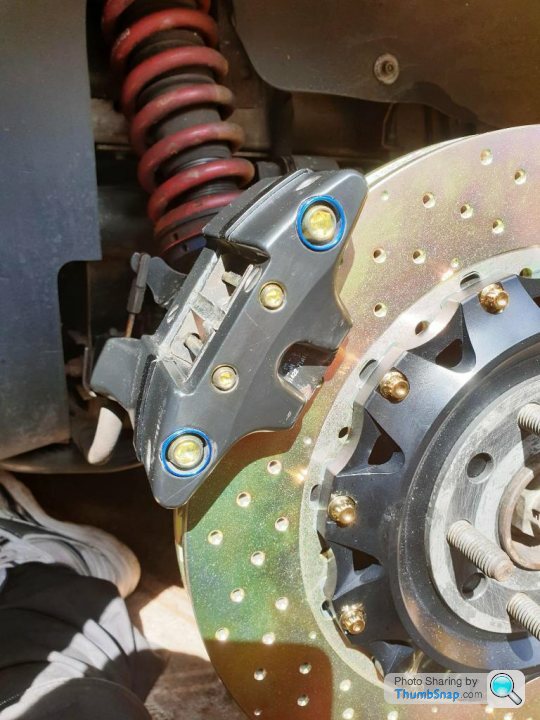
With the modified mounting position and the widened caliper, the handbrake calipers fit with the original M10x87x1.5 bolts and operate perfectly and still accept standard Aston Martin pads. In fact, operating on a higher radius, they are actually more efficient than standard due to the increased leverage ratio.
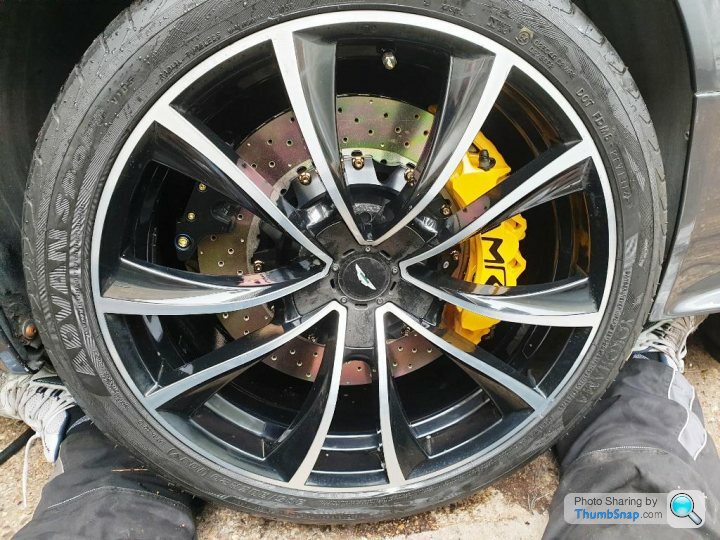
We then repeat for the other side before bleeding the braking system. As with the front brakes, the original hoses have a bracket permanantly attached to the chassis end of the flexible hose, so I modified the original bracket that attached to the original hose mounting position to secure the new braided hose fitting solidly in the same position.
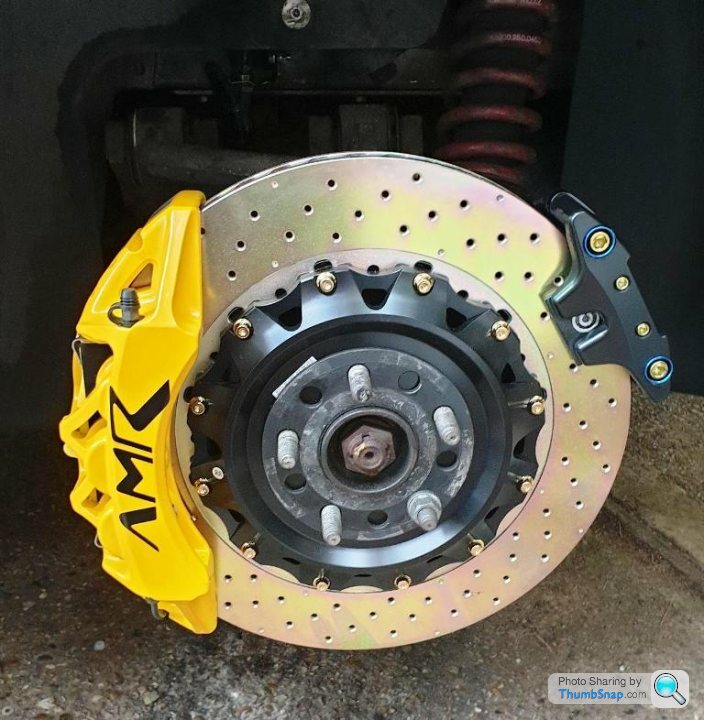
The car was then tested gently for brake function before putting it back in the garage for another day to fully start bedding-in the brakes and testing of the new system. In the initial feel, the brakes seemed to have greater stopping power with less pedal pressure, but with under a mile on them so far, I will wait to see how they feel under more demanding use.
So today I did the ATE Type 200 DOT4 Racing brake fluid change. This is the premium fluid in the ATE DOT4 range with the highest boiling point, both wet and dry, the best water absorption qualities, and was designed for high performance use, and exceeds the ATE DOT 5.1 spec fluid properties.
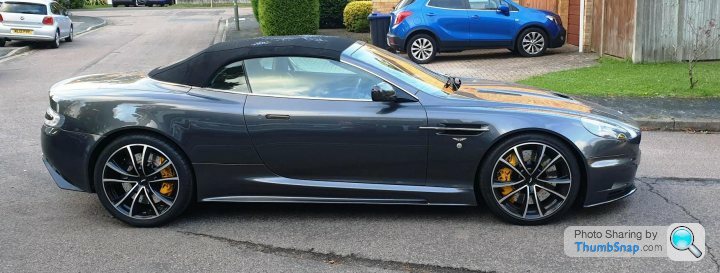
I did the fluid change the laborious pump, release, pump, release method with a slight modification that I do when I do this task. Doing it the usual way means that although the bulk of the fluid is replaced, there is always a reasonable amount trapped in the caliper and all you end up doing is reducing the content of old fluid, so I use the wedge method.
Using a few plastic door wedges, I push the pads (and therefore the pistons) back as far as they will go into the caliper body, and then wedge then these by tapping a plastic door wedge between the disc and the pad. I do this for all pads on all four calipers. This pushes out all of the existing fluid out of the caliper. I then vacuum out as much brake fluid from the reservoir as I can and refill it with fresh fluid. I then go round, starting at the rear, all the calipers bleeding inside pistons first and then the outer pistons. With no old fluid trapped in the caliper body, this virtually eliminates any risk of contamination with any old fluid. Then its the usual pedal down, bleed caliper, pedal up, repeat etc. Once the fresh fluid comes through, or after around 10 pumps per bleed nipple (if the old fluid was visually ok), I remove the wedges and pump the brakes up. This refills the calipers with the fresh fluid. Check and top up as necessary and it’s done.
I went out for a short legal drive and the pedal feels much more effective, with far less pedal pressure required for the same stopping power.
Clearly, this is a seat-of-the-pants judgement as it was a bit involved going to the trouble of measuring pedal pressure and comparing it on the MOT brake dyno, and I must state that braking distances are unaffected under normal driving because the ultimate braking limit on a car with ABS is the tyre to road surface grip coefficient, but less pedal pressure for the same braking effect does inspire confidence and I doubt I will suffer brake fade with the extra brake capacity.
And the whole lot for less cost than a pair of Carbon Ceramic discs!
I found some 8-pot calipers in Japan that utilise Brembo race caliper fitment pads that are used on the Audi R8, RS3/4/5/6 and TTRS. This makes sourcing a full range of pad applications and manufacturers very straightforward and replaces the standard 4-pot DB9 calipers. I will be using EBC DP41513R Yellow Stuff or DP51513 Blue Stuff pads.
Each forged, one piece front caliper houses 4 individual brake pads and is CNC machined to reduce weight and increase heat dissipation and the usual fitment of these calipers is on GT racing cars. The brake hose is attached with Titanium banjo bolts and the pads held in position with pins locked with stainless steel “R” clips. New nylon coated, stainless steel braided brake hoses are used for connection between the caliper and the vehicle.



The multi-piece discs are 400mm diameter (up from 355mm) and 36mm thick (up from 32mm), with lightweight alloy anodised center bells attached through sprung loaded floating mounts with twelve, 10.9 grade hi-tensile screws and locknuts.



Weight comparisons with the standard 4 pot calipers are as follows:
Front 8-pot caliper 4200g
400mm 2-piece brake disc 12535g
Swept area 663 cm²
OEM front 4-pot caliper 3100g
OEM front brake discs 12020g
OEM Swept area 556 cm
Combined installed weight of 8-pots 33470g
Combined weight of OEM brakes 30240g
Unsprung weight change +11%
Braking area increase front is 20%
Brake fluid used: ATE Type 200 DOT 4.
So, the process for replacing the stock Brembo 4-Pots with the new 8-Pots was as follows.
(Please note, pics taken on a phone, one handed, whilst going through the process so not up to Haynes standards!)
I will be using the following terminology:
Parking brakes are usually called handbrakes in the UK but with new technologies of foot operated “handbrakes” and electric “handbrakes, I am using the technically correct term of parking brake.
Service brakes are the brakes operated by the footbrake pedal whilst driving, not operating a foot operated parking brake “handbrake”. Confused? Let get on with it anyway......
So here we are at the starting point, stock DB9 calipers with drilled discs and a Titanium nut and stud caliper mounting install.

The car is lifted and supported (shown here on the offside) and the wheel removed.

First procedure was to remove the existing pads from the caliper by gently drifting out the pad retaining pins.

With the pins and anti-chatter clip removed, we can ease back the pads from the disc with a screwdriver.

At this point we can crack off the radial caliper retaining bolts. I have previously installed the titanium nut and stud conversion to prevent hub thread damage so here I can be seen removing the 15mm titanium nuts. This kit will not be reused.

At this point, prior to removal of the calipers, it it wise to make sure you can crack off the caliper hose union whilst the caliper is still secure, also, remove the 2 5mm nexagonal socket screws that retain the disc to the hub as you can wedge the disc from rotating with a screwdriver in the disc slots.

The caliper can now be removed......but do NOT let it hang on the brake hose, either support its weight with a box/block or support it as I have done on the top. You do NOT want to stress or twist/fold/bend the brake hose.

With the caliper free, and the disc retaining screws removed, the disc can be slid off the wheel studs.

With the disc now off and the hub exposed, you can check the wheel bearing for smooth, quiet operation easily, and you can thoroughly clean the hub/disc mounting face. Wire brush, fine abrasive paper and a clean cloth to ensure a perfectly flat mating face for the new disc.
We can now install the adaptor plate for the new 8-Pot calipers to the existing hub carrier.

Followed by the replacement disc

These calipers require the pads to be installed from the underside, so we now pre-load the four pads into the caliper body, preferably with the VAG type loomed pad towards the upper section of the inside position.

and the new 8-Pot caliper, secured by the 2 hexagon socket bolts.


At this point, I chose to retain the pad loom warning system, so as both the AM and the VAG use a 2 wire loom system, it was a simple task to cut and strip both looms....

Then reconnecting them together to remake a circuit, soldered, insulated with heatshrink and then bound again in insulating tape to double seal them.

At this point it was necessary to install a replacement braided steel, nylon coated brake hose, but due to brake fluid covered hands and the general mess involved, no pics were taken of the process. Unusually, the original hoses have a bracket permanantly attached to the chassis end of the flexible hose, so I made a bracket that attached to the original hose mounting position to secure the new braided hose fitting solidly in the same position.
With the new hose fitted, the new hose and caliper were bled, inside 4 pistons first, followed by the outer 4.

I then refitted the wheel and spun it to check for any binding or undue noises.

The car was then lowered back onto its wheels and the wheel nuts torqued to spec.

The whole procedure was then repeated on the nearside.

With that all successfully complete, it was time to tackle the rears, with the 4 caliper set-up and the new 380mm discs and 6-Pot calipers.
For the rear on my brake upgrade project, I decided to match my front lightweight forged aluminium calipers with carbon steel drilled floating discs, but this time with 6-pot calipers and discs in 380mm, 20mm larger than the DBS OEM and replacing the 4-pot calipers of the DB9.
I found some 6-pot calipers in Japan that utilised Alcon/AP Racing race caliper fitment pads that are used commonly in the AP CP5060/5555/5575 series of calipers, used on Holden Commodore and HSV, again making sourcing a full range of pad applications and manufacturers very straightforward. I have selected either EBC DP4032R Yellow Stuff or DP5032NDX Blue Stuff pads.


Each forged, one piece front caliper houses a pair of brake pads and like the fronts, is CNC machined to reduce weight and increase heat dissipation.
The multi-piece discs are 380mm diameter (up from 330mm) and 32mm thick (up from 28mm) and of identical construction to the fronts.
Weight comparisons with the standard 4 pot calipers are as follows:
Rear 6-pot caliper 2545g
380mm 2-piece brake disc 10725g
Swept area 583cm²
OEM rear 4-pot caliper 2655g
OEM rear brake discs 9298g
OEM drilled rear brake discs 8385g
OEM Swept area 372cm
Combined installed weight of 6-pots 26540g
Combined weight of OEM brakes 23906g
Unsprung weight change 11%
Braking area increase rear is 57%
As with the front brake installation, the vehicle is raised and supported with the wheel clear.
The first task is to remove the rear wheel assembly.

Now is a good time to remove the 2 disc securing screws retaining the disc to the hub.

As with the front brakes, the rear service calipers are radial mounted, so first task is to loosen the mounting bolts and remove the rear service calipers in the same way as we did the fronts. Firstly the upper caliper bolt


Followed by the lower

Then supporting the caliper so that it does not hang on the brake hose.

We can now loosen the rear caliper brake hose union, and remove the rear service calipers, allowing clearance to remove the rear disc once the parking caliper is also removed.
As before on the front, the disc/hub mounting face should be thoroughly cleaned.

Here we can see the old copper grease and accumulated dirt on the hub. This was washed down with aerosol brake cleaner/degreaser, then scrubbed with a wire brush to remove any hint of corrosion

And then washed again in brake cleaner.
I then had to install the new 6 pot caliper mounting brackets to the original caliper mounting points using M12x25x1.5 bolts for the inner bracket and M12x20x1.25 bolts for the outer bracket to the inner bracket.

Before offering up the new 380mm disc

The new brake pads were then installed into the new calipers

Before bolting up the new caliper using M12x57x1.25 hexagon socket bolts.

We also have the additional parking brake calipers fitted to the rear but these are more conventionally mounted. It is convenient to loosen the caliper body bolts whilst the caliper is held in position, and the pad pins can be removed and the parking brake pads withdrawn. The parking brake calipers can now be removed and moved aside by removing the 7mm hexagonal socket bolts at the rear.
The standard handbrake calipers have been retained but remounted to increase their diameter offset to accomodate the larger diameter discs,
Here we remove the upper park brake caliper mounting bolt

Followed by the lower

To allow for the increased rear disc diameter, the park brake caliper had to be remounted further from the centre using an adaptor mount using M10x35x1.5 bolts


and spaced 8mm to sit over the wider discs.

For this, I had to modify my already modified handbrake calipers......
https://www.pistonheads.com/gassing/topic.asp?t=17...
using longer M10x80x1.5 Titanium bolts to hold the caliper together and modified M6x100x1.0 Titanium bolts to act as the sliders for the pads.




With the modified mounting position and the widened caliper, the handbrake calipers fit with the original M10x87x1.5 bolts and operate perfectly and still accept standard Aston Martin pads. In fact, operating on a higher radius, they are actually more efficient than standard due to the increased leverage ratio.

We then repeat for the other side before bleeding the braking system. As with the front brakes, the original hoses have a bracket permanantly attached to the chassis end of the flexible hose, so I modified the original bracket that attached to the original hose mounting position to secure the new braided hose fitting solidly in the same position.

The car was then tested gently for brake function before putting it back in the garage for another day to fully start bedding-in the brakes and testing of the new system. In the initial feel, the brakes seemed to have greater stopping power with less pedal pressure, but with under a mile on them so far, I will wait to see how they feel under more demanding use.
So today I did the ATE Type 200 DOT4 Racing brake fluid change. This is the premium fluid in the ATE DOT4 range with the highest boiling point, both wet and dry, the best water absorption qualities, and was designed for high performance use, and exceeds the ATE DOT 5.1 spec fluid properties.

I did the fluid change the laborious pump, release, pump, release method with a slight modification that I do when I do this task. Doing it the usual way means that although the bulk of the fluid is replaced, there is always a reasonable amount trapped in the caliper and all you end up doing is reducing the content of old fluid, so I use the wedge method.
Using a few plastic door wedges, I push the pads (and therefore the pistons) back as far as they will go into the caliper body, and then wedge then these by tapping a plastic door wedge between the disc and the pad. I do this for all pads on all four calipers. This pushes out all of the existing fluid out of the caliper. I then vacuum out as much brake fluid from the reservoir as I can and refill it with fresh fluid. I then go round, starting at the rear, all the calipers bleeding inside pistons first and then the outer pistons. With no old fluid trapped in the caliper body, this virtually eliminates any risk of contamination with any old fluid. Then its the usual pedal down, bleed caliper, pedal up, repeat etc. Once the fresh fluid comes through, or after around 10 pumps per bleed nipple (if the old fluid was visually ok), I remove the wedges and pump the brakes up. This refills the calipers with the fresh fluid. Check and top up as necessary and it’s done.
I went out for a short legal drive and the pedal feels much more effective, with far less pedal pressure required for the same stopping power.
Clearly, this is a seat-of-the-pants judgement as it was a bit involved going to the trouble of measuring pedal pressure and comparing it on the MOT brake dyno, and I must state that braking distances are unaffected under normal driving because the ultimate braking limit on a car with ABS is the tyre to road surface grip coefficient, but less pedal pressure for the same braking effect does inspire confidence and I doubt I will suffer brake fade with the extra brake capacity.
And the whole lot for less cost than a pair of Carbon Ceramic discs!
Astontony said:
A great write up thanks. Out of interest do you have a ball park cost of all the parts. It would be of interest I am sure to those with carbon ceramics should there be a need to replace them and may be a more economical solution.
It is a good write up, but I’m not sure I’d want to change from carbon ceramics without prior discussion with insurers.Rightly or wrongly, CCs have a reputation for being the “best” and anything that is perceived as degrading braking performance could be negatively viewed, especially if it’s home developed rather than an officially sanctioned mod or a change to something that was available ex-factory.
First let me say, Im not one for after market mods myself but I have to admire the technical ability of the OP and excellent quality of write up here - top job!
Rightly or wrongly, CCs have a reputation for being the “best” and anything that is perceived as degrading braking performance could be negatively viewed, especially if it’s home developed rather than an officially sanctioned mod or a change to something that was available ex-factory.I agree changing your brakes like this would impact on insurance even if it could be proven they were an improvement they would still be classed as a mod.
The thing with CC’s is the unsprung mass weight saving and improved braking. The obvious downside and the only real reason people look negatively upon them is the cost of replcing.
I note that the OP says his brakes are 11% heavier than the OEM steel brakes from his DB9, which is 5.8kg more, albeit there is an even greater increase in braking pad area. The increase in unsprung weight therefore when swapping from CC’s to these would be even greater.
For me the unsprung weight saving is the biggest benefit of CC’s rather than improved braking which as has been said elsewhere is more than enough anyway on the OEM steels. Having driven Porsches with and without CC’s I found the benefit in tgis regard to be very noticeable and for rhat reason I would not want to give up that weight saving, but I can see that for cars equipped with steels these may make a more attractive option.
Would be interested to know the cost compared to new steel brakes?
Finally a question for the OP - why AMR logos? Is there some association with AMRacing, and if not why not just stay with factory style Aston Martin decals, or indeed the actual manufacturers logo?
LooneyTunes said:
Astontony said:
A great write up thanks. Out of interest do you have a ball park cost of all the parts. It would be of interest I am sure to those with carbon ceramics should there be a need to replace them and may be a more economical solution.
It is a good write up, but I’m not sure I’d want to change from carbon ceramics without prior discussion with insurers.Rightly or wrongly, CCs have a reputation for being the “best” and anything that is perceived as degrading braking performance could be negatively viewed, especially if it’s home developed rather than an officially sanctioned mod or a change to something that was available ex-factory.
The thing with CC’s is the unsprung mass weight saving and improved braking. The obvious downside and the only real reason people look negatively upon them is the cost of replcing.
I note that the OP says his brakes are 11% heavier than the OEM steel brakes from his DB9, which is 5.8kg more, albeit there is an even greater increase in braking pad area. The increase in unsprung weight therefore when swapping from CC’s to these would be even greater.
For me the unsprung weight saving is the biggest benefit of CC’s rather than improved braking which as has been said elsewhere is more than enough anyway on the OEM steels. Having driven Porsches with and without CC’s I found the benefit in tgis regard to be very noticeable and for rhat reason I would not want to give up that weight saving, but I can see that for cars equipped with steels these may make a more attractive option.
Would be interested to know the cost compared to new steel brakes?
Finally a question for the OP - why AMR logos? Is there some association with AMRacing, and if not why not just stay with factory style Aston Martin decals, or indeed the actual manufacturers logo?
Edited by AdamV12V on Monday 16th August 12:27
I have to say those look fantastic too, and really fill the wheel. Would they fit a 19' wheel would you have thought? Interested in the front/rear bias now, although the additional 20% swept area to the front and 57% to the rear might make the rears lock first?
Enjoyed the write up, excellent stuff. Wondering where you got the conversion brackets and the spacer for the parking brake caliper? Those would be the tricky things to source, I'd have thought...
Enjoyed the write up, excellent stuff. Wondering where you got the conversion brackets and the spacer for the parking brake caliper? Those would be the tricky things to source, I'd have thought...
LooneyTunes said:
Astontony said:
A great write up thanks. Out of interest do you have a ball park cost of all the parts. It would be of interest I am sure to those with carbon ceramics should there be a need to replace them and may be a more economical solution.
It is a good write up, but I’m not sure I’d want to change from carbon ceramics without prior discussion with insurers.Rightly or wrongly, CCs have a reputation for being the “best” and anything that is perceived as degrading braking performance could be negatively viewed, especially if it’s home developed rather than an officially sanctioned mod or a change to something that was available ex-factory.
https://www.design911shop.com/Replacement-for-CERA...
Astontony said:
A great write up thanks. Out of interest do you have a ball park cost of all the parts. It would be of interest I am sure to those with carbon ceramics should there be a need to replace them and may be a more economical solution.
$7500.00 USD for everything, discs, calipers, pads, hoses and bracketry. Around £5k.Interesting write-up, glad to hear you are happy with the new setup.
They certainly look good.
Are you planning to track the car at all? I ask for a few reasons:
- CCMs would have better thermal capacity despite the increase in size of the cast iron discs and increase in swept area
- slotting or dimpling would be a better choice for longevity instead of cross drilling
- despite the increase in total swept area, the multiple, smaller front pads might overheat more quickly. I had personal experience with this on my '04 RS6, which had impressive-looking, 8 piston calipers and multiple pads like your setup (shared with the Gallardo) that would overheat quickly on track. I converted to a six-piston Alcon setup with single, larger pads on each side that had substantially better thermal capacity.
They certainly look good.
Are you planning to track the car at all? I ask for a few reasons:
- CCMs would have better thermal capacity despite the increase in size of the cast iron discs and increase in swept area
- slotting or dimpling would be a better choice for longevity instead of cross drilling
- despite the increase in total swept area, the multiple, smaller front pads might overheat more quickly. I had personal experience with this on my '04 RS6, which had impressive-looking, 8 piston calipers and multiple pads like your setup (shared with the Gallardo) that would overheat quickly on track. I converted to a six-piston Alcon setup with single, larger pads on each side that had substantially better thermal capacity.
8Tech said:
LooneyTunes said:
Astontony said:
A great write up thanks. Out of interest do you have a ball park cost of all the parts. It would be of interest I am sure to those with carbon ceramics should there be a need to replace them and may be a more economical solution.
It is a good write up, but I’m not sure I’d want to change from carbon ceramics without prior discussion with insurers.Rightly or wrongly, CCs have a reputation for being the “best” and anything that is perceived as degrading braking performance could be negatively viewed, especially if it’s home developed rather than an officially sanctioned mod or a change to something that was available ex-factory.
https://www.design911shop.com/Replacement-for-CERA...
LooneyTunes said:
8Tech said:
LooneyTunes said:
Astontony said:
A great write up thanks. Out of interest do you have a ball park cost of all the parts. It would be of interest I am sure to those with carbon ceramics should there be a need to replace them and may be a more economical solution.
It is a good write up, but I’m not sure I’d want to change from carbon ceramics without prior discussion with insurers.Rightly or wrongly, CCs have a reputation for being the “best” and anything that is perceived as degrading braking performance could be negatively viewed, especially if it’s home developed rather than an officially sanctioned mod or a change to something that was available ex-factory.
https://www.design911shop.com/Replacement-for-CERA...
quench said:
Interesting write-up, glad to hear you are happy with the new setup.
They certainly look good.
Are you planning to track the car at all? I ask for a few reasons:
- CCMs would have better thermal capacity despite the increase in size of the cast iron discs and increase in swept area
- slotting or dimpling would be a better choice for longevity instead of cross drilling
- despite the increase in total swept area, the multiple, smaller front pads might overheat more quickly. I had personal experience with this on my '04 RS6, which had impressive-looking, 8 piston calipers and multiple pads like your setup (shared with the Gallardo) that would overheat quickly on track. I converted to a six-piston Alcon setup with single, larger pads on each side that had substantially better thermal capacity.
No, I don't want to track the car in the future, last time I did, I scrubbed-off £300+ worth of rubber in 12 minutes, I can't afford that and it's pointless unless you are pressing the car hard.They certainly look good.
Are you planning to track the car at all? I ask for a few reasons:
- CCMs would have better thermal capacity despite the increase in size of the cast iron discs and increase in swept area
- slotting or dimpling would be a better choice for longevity instead of cross drilling
- despite the increase in total swept area, the multiple, smaller front pads might overheat more quickly. I had personal experience with this on my '04 RS6, which had impressive-looking, 8 piston calipers and multiple pads like your setup (shared with the Gallardo) that would overheat quickly on track. I converted to a six-piston Alcon setup with single, larger pads on each side that had substantially better thermal capacity.
Dimpling traps gasses between the pads and the discs and I prefer drilled because it gives more immediate braking through water clearing than slotting.
I understand what you say but maybe the issue with the RS6 was pad choice, the Alcon brakes would have used race pads anyway as stock. This is also the reason I went for "skeleton" forged calipers rather than fully enclosed ones. A pain to change pads but far better thermal dissipation.
For pure road use, I can also buy type approved pads for £50.00 a set as opposed to £650.00 for CCM's if I choose to. Even my EBC fast road / track day pads were only about £100.00.
quench said:
Interesting write-up, glad to hear you are happy with the new setup.
They certainly look good.
Are you planning to track the car at all? I ask for a few reasons:
- CCMs would have better thermal capacity despite the increase in size of the cast iron discs and increase in swept area
- slotting or dimpling would be a better choice for longevity instead of cross drilling
- despite the increase in total swept area, the multiple, smaller front pads might overheat more quickly. I had personal experience with this on my '04 RS6, which had impressive-looking, 8 piston calipers and multiple pads like your setup (shared with the Gallardo) that would overheat quickly on track. I converted to a six-piston Alcon setup with single, larger pads on each side that had substantially better thermal capacity.
Thanks 8 tech, great value and as far as the comments re "your insurance company wont like that" as long as the car stops in a designated deemed roadworthy distance the insurers have no problem just like if you modify your suspension as long as it is a roadworthy addition there wont be any problems in australia.They certainly look good.
Are you planning to track the car at all? I ask for a few reasons:
- CCMs would have better thermal capacity despite the increase in size of the cast iron discs and increase in swept area
- slotting or dimpling would be a better choice for longevity instead of cross drilling
- despite the increase in total swept area, the multiple, smaller front pads might overheat more quickly. I had personal experience with this on my '04 RS6, which had impressive-looking, 8 piston calipers and multiple pads like your setup (shared with the Gallardo) that would overheat quickly on track. I converted to a six-piston Alcon setup with single, larger pads on each side that had substantially better thermal capacity.
$7500 usd is a lot nicer than $25000 usd and as some posters on here have said prior to your post, take the ceramics off put steels on like yours and when ready to sell put the ceramics back on. Your kit did nothing to change the ability to do this which is brilliant.
It is also interesting that most race cars perform on steels. If the cc brakes were so brilliant why wouldn't all race cars have them?
Hopefully as the years pas the price to replace cc's will come down substantially.
Astontony said:
Thanks 8 tech, great value and as far as the comments re "your insurance company wont like that" as long as the car stops in a designated deemed roadworthy distance the insurers have no problem just like if you modify your suspension as long as it is a roadworthy addition there wont be any problems in australia.
$7500 usd is a lot nicer than $25000 usd and as some posters on here have said prior to your post, take the ceramics off put steels on like yours and when ready to sell put the ceramics back on. Your kit did nothing to change the ability to do this which is brilliant.
It is also interesting that most race cars perform on steels. If the cc brakes were so brilliant why wouldn't all race cars have them?
Hopefully as the years pas the price to replace cc's will come down substantially.
No idea about Aus, but the comments about insurance were very valid indeed here in the UK, and it was UK members who made those comments. Clearly every country has its own industry standards on such things, so no-one intended to say if it is or is not acceptable globally.$7500 usd is a lot nicer than $25000 usd and as some posters on here have said prior to your post, take the ceramics off put steels on like yours and when ready to sell put the ceramics back on. Your kit did nothing to change the ability to do this which is brilliant.
It is also interesting that most race cars perform on steels. If the cc brakes were so brilliant why wouldn't all race cars have them?
Hopefully as the years pas the price to replace cc's will come down substantially.
I think you are confused - the OP had steel brakes on his car, and simply put bigger and heavier new steel brakes on to improve his braking performance. He didn't have CCMs, he said as much, he just mentioned them in one para, and it seems to have whipped up a negative frenzy of waffle about CCMs.
I'm really not sure why anyone with CCMs that were in perfect working order would take them off and put heavier steel brakes on even if they were bigger and potentially offered better braking performance, other than for the fear of future costs if they intended to track the car. But lets not forget that Astons are not really great track toys, there are far better cars to choose to whip around a track if that is your cup of tea.
The reality is that a car with CCMs that is looked after and never tracked is very unlikely to ever encounter the full cost of replacement that people worry about, so once you've bought the car all that remains are positives.
Gassing Station | Aston Martin | Top of Page | What's New | My Stuff





